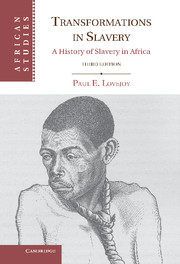Book contents
- Frontmatter
- Contents
- Maps and Tables
- Note on Currencies, Weights, and Measures
- Preface
- Preface to the Second Edition
- Preface to the Third Edition
- 1 Africa and Slavery
- 2 On the Frontiers of Islam, 1400–1600
- 3 The Export Trade in Slaves, 1600–1800
- 4 The Enslavement of Africans, 1600–1800
- 5 The Organization of Slave Marketing, 1600–1800
- 6 Relationships of Dependency, 1600–1800
- 7 The Nineteenth-Century Slave Trade
- 8 Slavery and “Legitimate Trade” on the West African Coast
- 9 Slavery in the Savanna during the Era of the Jihads
- 10 Slavery in Central, Southern, and Eastern Africa in the Nineteenth Century
- 11 The Abolitionist Impulse
- 12 Slavery in the Political Economy of Africa
- Epilogue
- Appendix Chronology of Measures against Slavery
- Notes
- Select Bibliography
- Index
- Books in this series
9 - Slavery in the Savanna during the Era of the Jihads
Published online by Cambridge University Press: 05 June 2012
- Frontmatter
- Contents
- Maps and Tables
- Note on Currencies, Weights, and Measures
- Preface
- Preface to the Second Edition
- Preface to the Third Edition
- 1 Africa and Slavery
- 2 On the Frontiers of Islam, 1400–1600
- 3 The Export Trade in Slaves, 1600–1800
- 4 The Enslavement of Africans, 1600–1800
- 5 The Organization of Slave Marketing, 1600–1800
- 6 Relationships of Dependency, 1600–1800
- 7 The Nineteenth-Century Slave Trade
- 8 Slavery and “Legitimate Trade” on the West African Coast
- 9 Slavery in the Savanna during the Era of the Jihads
- 10 Slavery in Central, Southern, and Eastern Africa in the Nineteenth Century
- 11 The Abolitionist Impulse
- 12 Slavery in the Political Economy of Africa
- Epilogue
- Appendix Chronology of Measures against Slavery
- Notes
- Select Bibliography
- Index
- Books in this series
Summary
The nineteenth century was a period of violent upheaval in the northern savanna and Ethiopia. From Senegambia in the west to the Red Sea in the east, the series of holy wars (jihads) that began in 1804 transformed most of this region, and slavery played a vital role in the transformation. The increased importance of slavery is evident in the export figures for slaves – 1,650,000 slaves sold north across the Sahara Desert and the Red Sea – but the jihads resulted in the enslavement of millions of other people who were settled within the new states. This led to a more intensive use of slaves in production, which further consolidated a political economy in which slavery was crucial and in that sense constituted a slave mode of production.
Increased slave use was related to two factors. First, some areas benefited from the export trade, which included not only slaves but steadily growing quantities of “legitimate” commodities. This expanding market for other merchandise, especially ostrich feathers, ivory, tanned skins, and gum arabic, was connected with the general economic growth of Europe in the nineteenth century. These commodities were taken across the Sahara, although gum arabic and peanuts were shipped from the Senegambia coast, and ivory and shea butter were exported via the Niger-Benue confluence. The second and most important factor was the expansion of the regional economies that were centered in the northern savanna itself. For the first time in centuries, there was no serious multiyear drought that undermined the economy, although drought still affected developments locally. Production in foodstuffs, livestock, textiles, and other manufactures expanded, especially in the new Islamic theocracies. A corresponding expansion occurred in commerce, with the result that the southern desert, the savanna, and the northern forest-zone were closely integrated, probably more so than ever before.
- Type
- Chapter
- Information
- Transformations in SlaveryA History of Slavery in Africa, pp. 185 - 218Publisher: Cambridge University PressPrint publication year: 2011



